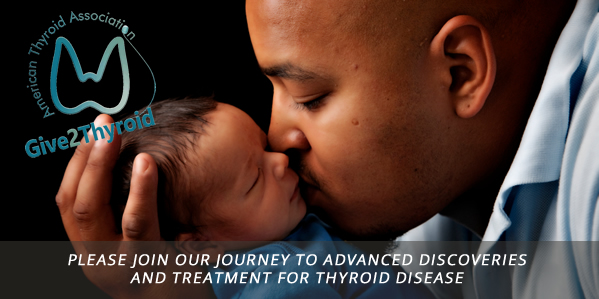Clinical Thyroidology for the Public summarizes selected research studies discussed in the previous month’s issue of Clinical Thyroidology, an official publication of the American Thyroid Association. Editor-in-chief, Alan Farwell, MD, FACE
Volume 11 Issue 9
Available in pdf format for saving and printing and Web page format for viewing online
PDF Format for Saving and Printing
Clinical Thyroidology for the Public Volume 11 Issue 9 (PDF file, 5.99 MB)
TABLE OF CONTENTS – Web Format
THYROID CANCER Analysis of clinical factors 1 year after surgery for thyroid cancer enables prediction of treatment-free survival
Treatment-free survival, which is living without the need for treatment for recurrent cancer, is an important outcome for thyroid cancer patients. The goal of this study was to understand factors associated with treatment-free survival in the general population, because this will enable the care teams to tailor long term follow up to a particular situation, and, many times, help decrease patient worry.
Banerjee M, Reyes-Gastelum D and Haymart MR 2018 Treatment-free survival in patients with differentiated thyroid cancer. J Clin Endocrinol Metab. Epub 2018 May 16. PMID: 29788217.
(PDF File for saving and printing, 227 KB)
THYROID NODULES Using the Thyroid Imaging Reporting and Data Systems (TIRADS) will decrease the number of thyroid nodule biopsies while improving diagnostic accuracy
Ultrasound is the imaging method of choice for evaluating thyroid nodules. TIRADS is a 5 point classification to determine the risk of cancer in thyroid nodules based on ultrasound characteristics. The aim of this study was to compare the biopsy rate and diagnostic accuracy before and after applying TIRADS risk stratification to patients with thyroid nodules.
Hoang JK et al 2018 Reduction in thyroid nodule biopsies and improved accuracy with American College of Radiology Thyroid Imaging Reporting and Data System. Radiology 287:185–193. Epub 2018 Mar 2. PMID: 29498593.
(PDF File for saving and printing, 117 KB)
THYROID NODULES Thyroid Imaging Reporting and Data Systems (TIRADS) accurately determine the risk of cancer in small thyroid nodules
Thyroid ultrasound is important in identifying a nodule and the appearance on ultrasound in addition to size are the key factors determining the need for biopsy. TIRADS is a 5 point classification to determine the risk of cancer in thyroid nodules based on ultrasound characteristics. This study explores the accuracy of TIRADS to predict cancer in thyroid nodules that are ≤ 1 cm.
Mendes GF et al 2018 Fine needle aspiration biopsy of thyroid nodule smaller than 1.0 cm: accuracy of TIRADS classification system in more than 1000 nodules. Br J Radiol 91:20170642. Epub 2017 Dec 22. PMID: 29182368.
(PDF File for saving and printing, 167 KB)
THYROID CANCER Giving radioactive iodine within 3 months after thyroidectomy results in better responses than delaying therapy beyond 3 months after surgery
Patients diagnosed with thyroid cancer usually have an excellent prognosis. This is due to both surgery and, when needed, radioactive iodine therapy. There is currently no agreement regarding the best timing of administration of radioactive iodine. The objective of this study was to evaluate the response to treatment when giving radioactive iodine within 3 months of thyroidectomy versus ≥3 months after surgery.
Li H et al 2018 Delayed initial radioiodine therapy related to incomplete response in low- to intermediate-risk differentiated thyroid cancer. Clin Endocrinol (Oxf ) 88:601–606. Epub 2018 Feb 18. PMID: 29338092.
(PDF File for saving and printing, 287 KB)
THYROID CANCER Implications of residual cancer in lymph nodes after surgery for patients with intermediate to high risk thyroid cancer.
Up to 50% of patients with intermediate-high risk thyroid cancer have clinically meaningful cancer that has spread to the lymph nodes at the time of surgery. Further, persistent or residual cancer in lymph nodes is the most common cause of recurrent thyroid cancer. This study’s aim was to identify the most common location of persistent lymph node cancer as well as the primary reason why there remained cancer in patients with intermediate and high risk thyroid cancer.
Miller JE et al 2018 Location and causation of residual lymph node metastases after surgical treatment of regionally advanced differentiated thyroid cancer. Thyroid 28:593–600. Epub 2018 Apr 23. PMID: 29562827.
(PDF File for saving and printing, 287 KB)
ATA ALLIANCE FOR THYROID PATIENT EDUCATION
2018 ATA Alliance for Thyroid Patient Education Health Forum





